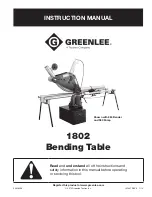
4. OPERATION
4.1.
USING THE WRENCH
4.1.1.
Fit the socket to the wrench by snapping it onto the square drive. Note: Use only impact grade sockets.
4.1.2.
Fit the battery pack to the wrench by aligning the tongue on the battery with the groove in the housing and slide into place. Ensure
that the battery pack is firmly located, A click will be heard when it has locked into position.
Select the required direction of rotation. To change direction, turn the direction control (fig.1) to the left or right.
change direction, turn the direction control (fig.1) to the left or right.
DO NOT
DO NOT
attempt to
attempt to
change the direction of rotation whilst trigger is depressed.
change the direction of rotation whilst trigger is depressed.
4.1.3.
Speed can be controlled by varying the finger pressure on the trigger. Initial pressure will switch on the worklight.
4.1.4.
4.1.4.
When tightening, take care not to over-torque small fixi
When tightening, take care not to over-torque small fixi
ngs.
Note: On critical fixings always check the torque with a torque wrench according to the product or vehicle manufacturer’s
guidelines.
WARNING! – Risk of Hand Arm Vibration Injury.
This tool may cause Hand Arm Vibration Syndrome if its use is not managed adequately.
This tool is subject to the vibration testing section of the Machinery Directive 2006/42/EC.
T
his tool is to be operated in accordance with these instructions.
M
easured vibration emission value (a): 2.898 m/s²
U
ncertainty value (k): 1.5 m/s²
P
lease note that the application of the tool to a sole specialist task may produce a different average vibration emission. We recommend that a
specific evaluation of the vibration emission is conducted prior to commencing with a specialist task.
A
health and safety assessment by the user (or employer) will need to be carried out to determine the suitable duration of use for each tool.
N
B: Stated Vibration Emission values are type-test values and are intended to be typical.
W
hilst in use, the actual value will vary considerably from and depend on many factors.
S
uch factors include; the operator, the task and the inserted tool or consumable.
N
B: ensure that the length of leader hoses is sufficient to allow unrestricted use, as this also helps to reduce vibration.
The state of maintenance of the tool itself is also an important factor, a poorly maintained tool will also increase the risk of Hand Arm Vibration
Syndrome.
Health surveillance.
W
e recommend a programme of health surveillance to detect early symptoms of vibration injury so that management procedures can be modified
accordingly.
Personal protective equipment.
W
e are not aware of any personal protective equipment (PPE) that provides protection against vibration injury that may result from the
u
ncontrolled use of this tool. We recommend a sufficient supply of clothing (including gloves) to enable the operator to remain warm and dry and
maintain good blood circulation in fingers etc. Please note that the most effective protection is prevention, please refer to the Correct Use and
Maintenance section in these instructions. Guidance relating to the management of hand arm vibration can be found on the HSC website
w
ww.hse.gov.uk - Hand-Arm Vibration at Work.
Original Language Version
© Jack Sealey Limited
C
P1204 | Issue 2 11/05/20
Sealey Group, Kempson Way, Suffolk Business Park, Bury St Edmunds, Suffolk. IP32 7AR
01284 757500
01284 703534
www.sealey.co.uk
Note
: It is our policy to continually improve products and as such we reserve the right to alter data, specifications and component parts without prior
notice.
Important
: No Liability is accepted for incorrect use of this product.
Warranty
: Guarantee is 12 months from purchase date, proof of which is required for any claim.
WEEE REGULATIONS
Dispose of this product at the end of its working life in compliance with the EU Directive on Waste Electrical and Electronic Equipment
(WEEE). When the product is no longer required, it must be disposed of in an environmentally protective way. Contact your local solid
waste authority for recycling information.
ENVIRONMENT PROTECTION
Recycle unwanted materials instead of disposing of them as waste. All tools, accessories and packaging should be sorted, taken to
a recycling centre and disposed of in a manner which is compatible with the environment. When the product becomes completely
unserviceable and requires disposal, drain any fluids (if applicable) into approved containers and dispose of the product and fluids
according to local regulations.




















